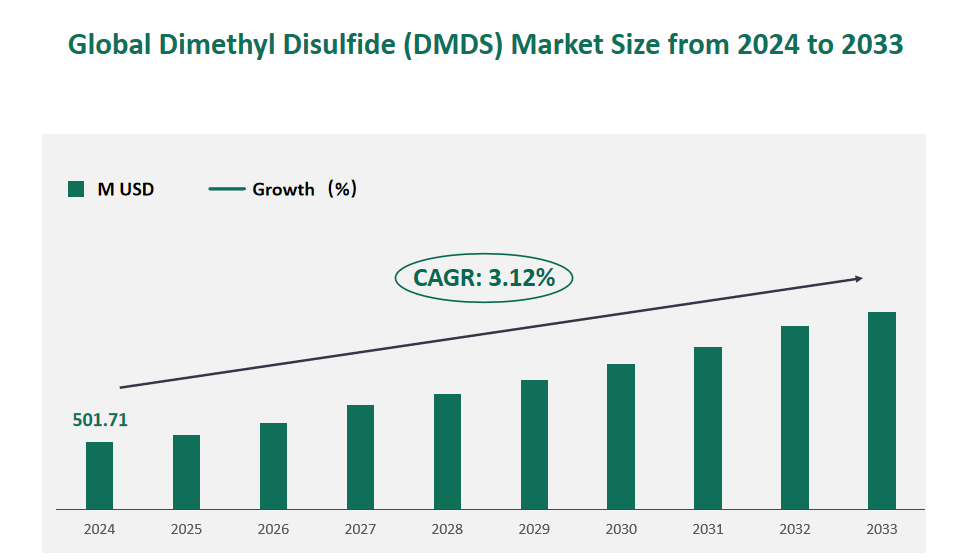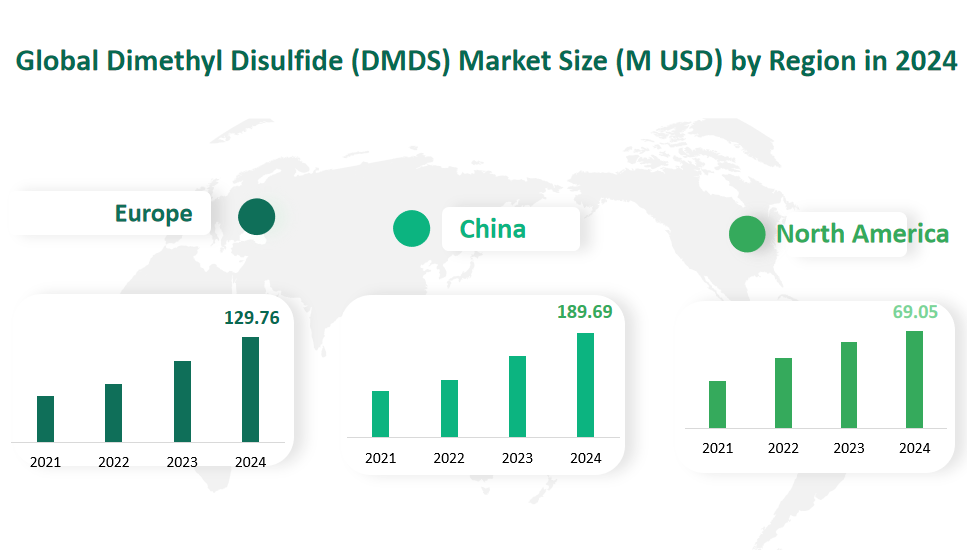1 Global Dimethyl Disulfide (DMDS) Market Size (Value) and CAGR (2024-2033)
In 2024, the global Dimethyl Disulfide (DMDS) market was valued at USD 501.71 million, with a CAGR of 3.12% from 2024 to 2033.
Dimethyl Disulphide (DMDS) is an organic chemical compound with CH3SSCH3 molecular formula and (Methyldisulfanyl) methane IUPAC name. A pale yellow liquid, it is the simplest disulphide compound. DMDS is a flammable liquid and has an unpleasant odour. The natural source of DMDS is Helicodiceros muscivorus, also known as dead-horse arum plant. Chlorination and oxidation are the important chemical reactions of DMDS.
Figure Global Dimethyl Disulfide (DMDS) Market Size (M USD) and CAGR 2024-2033

2 Dimethyl Disulfide (DMDS) Market Drivers
Growing Demand from Oil Refining Industry: DMDS is widely used as a catalyst activator and sulfur donor in the hydrodesulfurization process of oil refineries. This application is critical for reducing sulfur content in fuels, thereby meeting environmental regulations. As the global demand for cleaner fuels increases, the need for DMDS in refineries is also expected to rise.
Rising Pesticide Industry: In the agricultural sector, DMDS is an important intermediate for the production of various pesticides. The growing global population and the need for increased agricultural productivity are driving the demand for effective pesticides, thereby boosting the market for DMDS.
Expansion of the Food Industry: DMDS is used as a flavoring and fragrance component in the food industry. The expansion of the global food market, particularly in emerging economies, is creating additional demand for DMDS as a food additive.
Technological Advancements: Innovations in the production process of DMDS are expected to improve efficiency and reduce costs. This will make the product more accessible and competitive in the global market.
E-commerce and Logistics: The rapid development of e-commerce and logistics industries has improved the supply chain efficiency for DMDS. This has facilitated easier access to raw materials and enhanced the distribution of DMDS products, thereby supporting market growth.
3 Dimethyl Disulfide (DMDS) Market Limitations
Stringent Environmental Regulations: DMDS production and usage are subject to strict environmental regulations due to its sulfur content and potential for air pollution. Countries with stringent environmental policies, such as those in Europe and North America, may impose higher costs on DMDS producers, limiting market growth.
Health and Safety Concerns: DMDS is a flammable liquid with an unpleasant odor and poses health risks if not handled properly. These safety concerns can lead to additional regulatory hurdles and higher operational costs for manufacturers.
Regional Imbalances: The global DMDS market is characterized by significant regional imbalances in supply and demand. For instance, China is a major producer and consumer of DMDS, while regions like Africa and South America have limited production capabilities. This imbalance can lead to supply chain disruptions and increased transportation costs.
Competition from Alternative Products: The market for DMDS faces competition from alternative products that offer similar functionalities. These alternatives may be more environmentally friendly or cost-effective, posing a threat to the market share of DMDS.
4 Global Dimethyl Disulfide (DMDS) Market Size by Type in 2024
Industrial Grade DMDS is the predominant type, characterized by its high purity and stability. It is a pale yellow liquid with a high sulfur content, making it an essential component in various industrial processes. Industrial Grade DMDS is primarily used as a catalyst activator in the oil refining industry, where it plays a crucial role in the hydrodesulfurization process. This process helps remove sulfur compounds from petroleum products, ensuring compliance with environmental regulations and improving fuel quality.
Additionally, Industrial Grade DMDS is utilized in the petrochemical industry as a passivation agent to prevent the formation of coke and carbon monoxide in steam-cracking coils. Its high sulfur content also makes it an effective intermediate in the production of methanesulfonyl chloride and methanesulfonic acid. In 2024, Industrial Grade DMDS accounted for approximately 88.02% of the total market value, reflecting its widespread use across multiple industrial applications.
Food Grade DMDS, on the other hand, is designed for applications in the food industry. It is typically characterized by higher purity standards to ensure safety for human consumption. Food Grade DMDS is used as a flavoring and fragrance component, adding specific aroma profiles to food products. It is also employed as a food additive to enhance the sensory attributes of various food items. While its market value is significantly lower compared to Industrial Grade DMDS, Food Grade DMDS plays a vital role in the food industry, contributing to the overall market dynamics. In 2024, Food Grade DMDS accounted for 11.98% of the total market value, highlighting its niche but essential role in the global DMDS market.
Table Global Dimethyl Disulfide (DMDS) Market Size by Type in 2024
Type | Market Size (M USD) 2024 |
Industrial Grade | 441.39 |
Food Grade | 60.32 |
5 Global Dimethyl Disulfide (DMDS) Market Size by Application in 2024
The global Dimethyl Disulfide (DMDS) market is segmented into several key applications, each contributing to the overall market value. In 2024, the market value of DMDS across different applications was distributed as follows: the chemical industry accounted for 273.18 million USD, the pesticide industry for 167.55 million USD, the food industry for 59.11 million USD.
DMDS is predominantly used in the chemical industry, where it serves as a crucial catalyst activator in hydrodesulfurization processes, essential for removing sulfur compounds from petroleum products. This application is critical for meeting environmental regulations and improving fuel quality. Additionally, DMDS is used as a passivation agent in petrochemical processes to prevent the formation of coke and carbon monoxide in steam-cracking coils. The chemical industry’s significant demand for DMDS is driven by the continuous need for efficient and effective catalysts in refining and petrochemical operations.
In the pesticide industry, DMDS is used as an intermediate for the production of various pesticides. Its high sulfur content makes it an effective component for developing agricultural chemicals that protect crops from pests and diseases. The growing global population and the increasing demand for agricultural productivity drive the need for effective pesticides, thereby supporting the market for DMDS in this sector.
The food industry also benefits from DMDS, primarily as a flavoring and fragrance component. It is used to enhance the sensory attributes of food products, adding specific aroma profiles that improve the overall consumer experience. While the market value of DMDS in the food industry is relatively smaller compared to the chemical and pesticide sectors, it remains a vital component for food manufacturers seeking to enhance product quality.
Table Global Dimethyl Disulfide (DMDS) Market Size by Application in 2024
Application | Market Size (M USD) 2024 |
Chemical industry | 273.18 |
Pesticide | 167.55 |
Food | 59.11 |
Others | 1.87 |
6 Global Dimethyl Disulfide (DMDS) Market Size by Region in 2024
China is the largest producer and consumer of DMDS, accounting for nearly 37% of the global market value in 2024. The rapid economic growth and industrialization in China have driven the demand for DMDS, particularly in the chemical and pesticide industries. The country’s significant downstream market and technological advancements have positioned it as a dominant player in the global DMDS market. China’s market is characterized by a large number of manufacturers, with companies like Langfang Jinshenghui Chemical and Taizhou Sunny being key players. The government’s support for industrial development and infrastructure projects further fuels the demand for DMDS in the region.
Europe is the second-largest market for DMDS, with a market value of 129.76 million USD in 2024. The region’s demand is primarily driven by the chemical industry, where DMDS is used in various refining and petrochemical processes. European companies are also at the forefront of technological innovation, focusing on developing more sustainable and efficient DMDS production methods. The presence of major chemical companies like Arkema and Chevron Phillips Chemical in Europe contributes significantly to the market. However, stringent environmental regulations and high labor costs pose challenges to the industry, requiring companies to invest in advanced technologies to remain competitive.
North America, particularly the United States, is another significant market for DMDS, with a market value of 69.05 million USD in 2024. The region’s strong oil refining and agricultural sectors drive the demand for DMDS as a catalyst activator and pesticide intermediate. The presence of major chemical companies and a robust industrial infrastructure supports the continuous growth of the DMDS market in North America. Companies like Chevron Phillips Chemical have a strong market presence, contributing to the region’s market value.
Figure Global Dimethyl Disulfide (DMDS) Market Size by Region in 2024

7 Major Players in Global Dimethyl Disulfide (DMDS) Market
7.1 Arkema
Arkema is a leading global chemical company with a strong presence in the DMDS market. Established in 2003, Arkema operates manufacturing plants primarily in Europe and Malaysia, catering to a worldwide sales region. The company’s business overview highlights its focus on high-performance materials, including adhesives, sealants, and specialty polyamides used across various industries such as automotive, aerospace, and electronics. Arkema’s DMDS product, known as DMDS Evolution®E2, is a breakthrough formulation designed for better odor control and performance as a sulfiding agent in refineries and steam crackers. In the most recent year, Arkema reported a production value of 99.71 million USD, with a gross margin of 20.74%.
7.2 Langfang Jinshenghui Chemical
Langfang Jinshenghui Chemical is another major player in the DMDS market, with a strong foothold in China. Founded in 1994, the company specializes in the manufacturing of industrial organic chemicals. Its business overview emphasizes the production of high-purity DMDS, which is widely used as a solvent and intermediate in the oil refining and pesticide industries. Langfang Jinshenghui Chemical’s DMDS product is characterized by its high purity (99.5% minimum) and low water content, making it suitable for various industrial applications. In the latest financial year, the company achieved a production value of 34.86 million USD, with a gross margin of 17.16%.
7.3 Chevron Phillips Chemical
Chevron Phillips Chemical is a prominent player in the global DMDS market, known for its extensive chemical and petrochemical product portfolio. Established in 2000, the company operates primarily in the United States and serves customers worldwide. Chevron Phillips Chemical’s business overview includes the production of specialties, aromatics, and styrenics used in various industrial applications, including electronics, automobiles, and pharmaceuticals. The company’s DMDS product is recognized for its safety and handling properties, making it suitable for use in high-ambient-temperature environments. In the most recent year, Chevron Phillips Chemical reported a production value of 42.64 million USD, with a gross margin of 18.96%.

